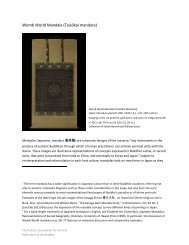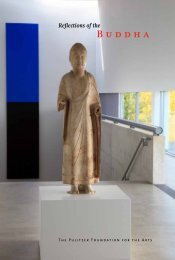Four-circle Hevajra Mandala - Reflections of the Buddha
Four-circle Hevajra Mandala - Reflections of the Buddha
Four-circle Hevajra Mandala - Reflections of the Buddha
Create successful ePaper yourself
Turn your PDF publications into a flip-book with our unique Google optimized e-Paper software.
<strong>Four</strong>-<strong>circle</strong> <strong>Hevajra</strong> <strong>Mandala</strong> 2<br />
“Highest Yoga Tantras,” <strong>of</strong> <strong>the</strong> Sakya school. The Highest Yoga Tantras are one <strong>of</strong> <strong>the</strong> four types <strong>of</strong><br />
tantras in Vajrayāna Buddhism, 5 <strong>the</strong> tantras being systems <strong>of</strong> practice, usually based on specific texts,<br />
that are meant to enable <strong>the</strong> practitioner to attain <strong>Buddha</strong>hood through meditative engagement with a<br />
particular tutelary deity. The Highest Yoga Tantras are believed to allow attainment <strong>of</strong> <strong>Buddha</strong>hood in a<br />
single lifetime. They demand that <strong>the</strong> practitioner follow a teacher’s instructions in performing radical<br />
inner transformations—for example, visualizing his body as a particular arrangement <strong>of</strong> deities both<br />
male and female, and fur<strong>the</strong>r visualizing himself as nei<strong>the</strong>r different from nor <strong>the</strong> same as those deities.<br />
These tantras particularly emphasize <strong>the</strong> simultaneous unity <strong>of</strong> and difference between wisdom and<br />
compassion. Because wisdom is considered a female attribute in Buddhist thought and compassion a<br />
male attribute, sexual metaphors and imagery are used extensively. In contemplating such metaphors<br />
and imagery, “desire is converted to bliss, hatred to radiance, and delusion to awareness, and <strong>the</strong> union<br />
<strong>of</strong> male and female is transformed into <strong>the</strong> nondual state <strong>of</strong> compassion and wisdom <strong>of</strong> a <strong>Buddha</strong>.” 6<br />
Importantly, as can be seen in this thankga, <strong>the</strong> deities depicted in ecstatic, sexual embrace are<br />
pr<strong>of</strong>oundly wrathful ones. They all bear various weapons, some trample upon corpses, and o<strong>the</strong>rs wear<br />
garlands <strong>of</strong> skulls. Vajrayāna practitioners understand <strong>the</strong> fearsome appearance <strong>of</strong> <strong>the</strong>se deities to be,<br />
in fact, an outward manifestation <strong>of</strong> <strong>the</strong>ir compassion. By directing <strong>the</strong>ir wrath against <strong>the</strong> obstacles<br />
that hinder worshippers’ progress along <strong>the</strong> path to awakening, <strong>the</strong>se deities display <strong>the</strong>ir compassion<br />
for <strong>the</strong>ir followers. They manifest, in essence, “benevolent wrath.” 7<br />
These four manifestations <strong>of</strong> <strong>Hevajra</strong> are depicted at <strong>the</strong> center <strong>of</strong> a mandala—an array <strong>of</strong> deities<br />
positioned within a palace-like architectural setting, meant to be envisioned as a fully three-dimensional<br />
space. <strong>Mandala</strong>s are usually created in accompaniment to meditative practices in which <strong>the</strong> practitioner<br />
visualizes himself in union with—or as—those deities. 8 While <strong>the</strong> deities depicted within a mandala may<br />
vary, and while stylistic differences may always be identified, <strong>the</strong> basic structure <strong>of</strong> mandalic<br />
compositions remains generally constant across all periods and places <strong>of</strong> Vajrayāna Buddhism. The<br />
structure <strong>of</strong> each <strong>of</strong> <strong>the</strong> four mandalas depicted on this thangka might be best understood by taking a<br />
5 The four types are Kriyā-tantra (Action Tantra), Caryā-tantra (Performance Tantra), Yoga-tantra (Yoga Tantra),<br />
and Anuttarayoga-tantra (Highest Yoga Tantra). A brief introduction to <strong>the</strong> different types <strong>of</strong> tantras may be<br />
found in Dina Bangdel and Aviana P. Maki, “Related Esoteric Tantras,” in Huntington and Bangdel, pp. 422-423.<br />
6 Ibid., p. 423.<br />
7 For more on <strong>the</strong> notion <strong>of</strong> “benevolently wrathful” deities, see Rob Linro<strong>the</strong>, “Protection, Benefaction, and<br />
Transformation: Wrathful Deities in Himalayan Art,” in Rob Linro<strong>the</strong> and Jeff Watt, Demonic Divine: Himalayan Art<br />
and Beyond (New York: Rubin Museum <strong>of</strong> Art, 2004), pp. 3-43.<br />
8 <strong>Mandala</strong>s are <strong>of</strong>ten described as “visualization (or meditation) aids.” The texts that prescribe <strong>the</strong> creation <strong>of</strong><br />
mandalas, however, never explicitly describe how <strong>the</strong> worshipper is to interact with mandala, even though such<br />
texts <strong>of</strong>ten tell <strong>the</strong> worshipper to create a physical mandala according to precise instructions and <strong>the</strong>n to construct<br />
an identical mandala in his mind. Thus, while <strong>the</strong> creation <strong>of</strong> <strong>the</strong> physical mandala may help practitioners to<br />
familiarize <strong>the</strong>mselves with <strong>the</strong> deities that <strong>the</strong>y envision during meditative practice and to focus <strong>the</strong>ir mind on<br />
those deities, it cannot be asserted with absolute certainty that a mandala is explicitly used during actual<br />
meditative practice. This is not to say that physical mandalas do not serve any precise ritual faction. Indeed,<br />
during some consecration rites (Sanskrit: abhiseka), a mandala may be laid out on a raised altar, onto whose<br />
deities each new initiate into <strong>the</strong> practices associated with <strong>the</strong> mandala tosses a flower petal, taking as his tutelary<br />
deity <strong>the</strong> figure onto which <strong>the</strong> flower petal falls. The Kamakura-period (1185-1333) Womb World <strong>Mandala</strong> also<br />
on display in “<strong>Reflections</strong> <strong>of</strong> <strong>the</strong> <strong>Buddha</strong>” could have been used in such a way, though as David Snellgrove points<br />
out, given that mandalas like this <strong>Four</strong>-Circle <strong>Hevajra</strong> <strong>Mandala</strong> focus on only a single presiding deity, it is unlikely<br />
that <strong>the</strong>y would have been used in a similar consecration ritual. See David Snellgrove, Indo-Tibetan Buddhism:<br />
Indian Buddhists and Their Tibetan Successors (Boston: Shambhala, 2002), p. 180.<br />
The Pulitzer Foundation for <strong>the</strong> Arts<br />
<strong>Reflections</strong> <strong>of</strong> <strong>the</strong> <strong>Buddha</strong>




